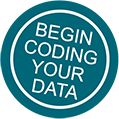Collecting and Using Industry and Occupation Data
Code
Once you’ve got text descriptions of industry and occupational data, you’ll need to code your data. Here you will learn about standardized codes and options for autocoding industry and occupation data.
About Coding Data
Industry and occupation coding is the process of converting a description (free text) of a person’s job and type of business into a standardized numeric code.
- Industry and occupation codes follow U.S. standards.
- Review the classification systems and decide which to use before coding your data.
- Use an autocoder to code your data, such as NIOCCS.
- You can code data as you collect it, or after collection is complete.
Coding the data allows public health officials and other researchers to assess patterns and trends in work-related diseases, injuries, and exposures.
Before Coding Data
These are the most important things to understand when coding data.
- Codes follow U.S. standards.
Each industry and occupation has a unique number associated with it. These standardized codes are needed for data analysis and can be grouped into broader categories. - You will need to choose a classification system to code your data.
- North American Industry Classification System (NAICS)
NAICS can be used to assign industry codes.
- Standard Occupational Classification System (SOC)
SOC can be used to assign occupation codes.
- Census Industry and Occupation Classification System
Census can be used to assign both industry codes and/or occupation codes. Census industry and Census occupation codes are often used as a pair. Census industry classification is derived from NAICS. Census occupation classification is derived from SOC.
Industry and occupation codes are standardized and specific. Codes depend on the classification system you use.
Example
A survey respondent says their industry is “flooring installation” and their occupation is “carpet layer”
| Industry: “Floor installation” | NAICS code: 238330 |
| Occupation: “Carpet layer” | SOC Code: 47-2041 |
| Industry: “Floor installation” | Census code: 0070 |
| Occupation: “Carpet layer” | Census code: 6240 |
Deciding Which Classification System(s) to Use
Determine if you want to compare your data to another dataset.
Use an Autocoder to Code Your Data
Software applications, or “autocoders,” are available to code industry and occupation data. Autocoders assign industry and occupation codes to free-text descriptions using the classification system you choose (NAICS and SOC, or Census).
There are many advantages when using an autocoder:
- Autocoding is much faster than manual coding.
- There is greater consistency in codes from one record to another, which means less random error.
- Manual coding requires training and experience.
Decide if You Want to Code During Data Collection or After
If you want to code AFTER data collection
Use the NIOSH Industry and Occupation Computerized Coding System (NIOCCS) if you want to code AFTER you collect data.
NIOCCS is a free autocoder that codes large files of industry and occupation free-text descriptions to Census industry and occupation codes, NAICS codes, and SOC codes.
NIOCCS can also crosswalk data. Crosswalking is the mapping of a code from one industry or occupation classification system to another, or to a different code within the same industry and occupation classification system for a different year.
Classification systems are updated regularly, so crosswalk files help link data across classification systems to enable analysis. Learn more about crosswalking for NAICS, SOC, and Census.
If you want to code DURING data collection
Use one of these to code WHILE you collect data:
- NIOCCS Single Record Coding Service can code industry and occupation data one entry at a time, but it requires you to switch back and forth between your data entry program and the NIOCCS website.
- NIOCCS Web Service Autocoder can be incorporated into any data collection platform and requires only an internet connection. It converts free-text industry and occupation descriptions into standardized codes as data are collected.
- Epi Info, version 7.2.4 includes tools to code occupation and industry data as you go. Learn more

